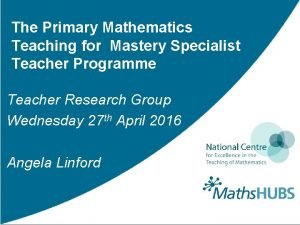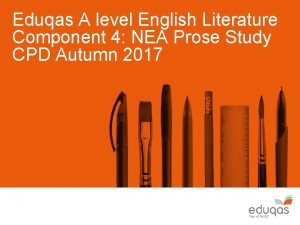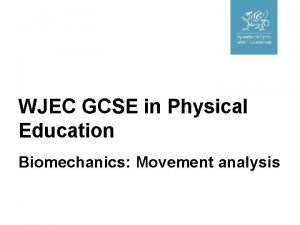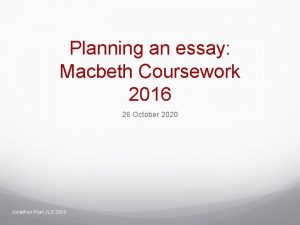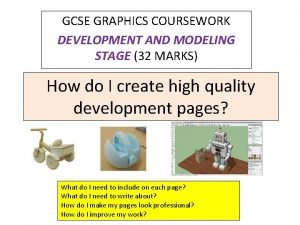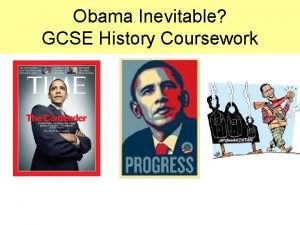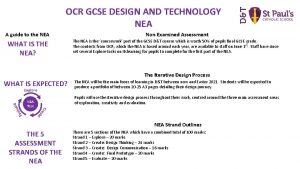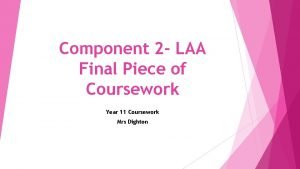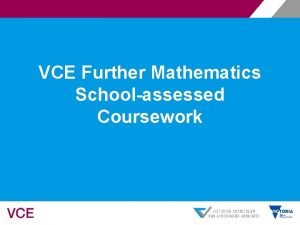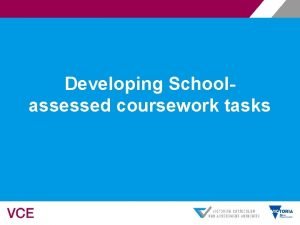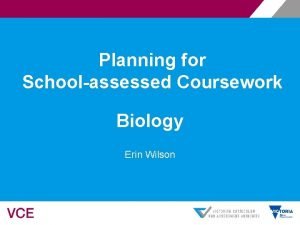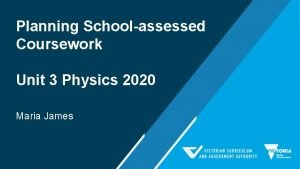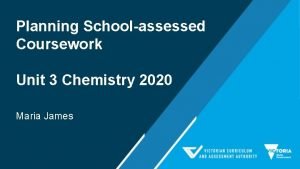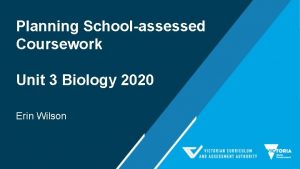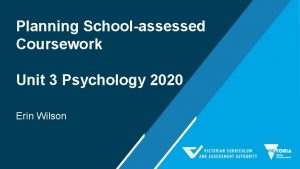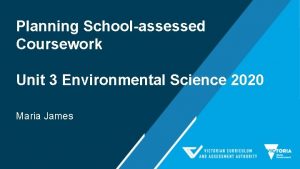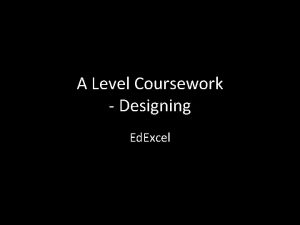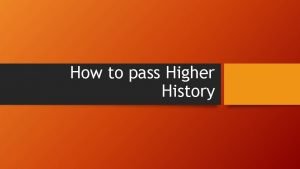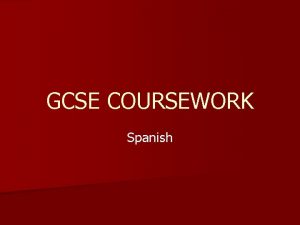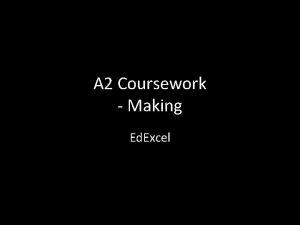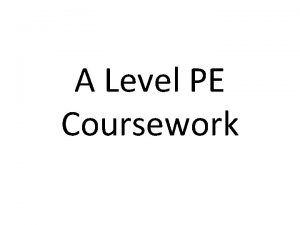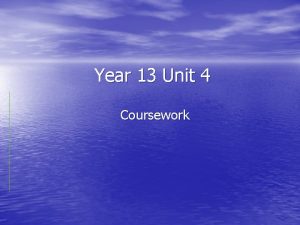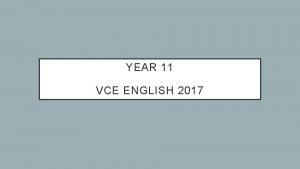VCE Specialist Mathematics Schoolassessed Coursework Copyright The copyright




























































- Slides: 60

VCE Specialist Mathematics School-assessed Coursework

Copyright The copyright in this Power. Point presentation is owned by the Victorian Curriculum and Assessment Authority or in the case of some materials, by third parties. No part may be reproduced by any process except in accordance with the provisions of the Copyright Act 1968 or with permission from the Copyright Officer at the Victorian Curriculum and Assessment Authority.

VCE assessment principles Assessment is an integral part of teaching and learning at the senior secondary level that: - identifies opportunities for further learning - describes student achievement - articulates and maintains standards - provides the basis for the award of a certificate.

VCE assessment principles As part of VCE studies, assessment tasks enable: - the demonstration of the achievement of an outcome or set of outcomes - judgment and reporting of a level of achievement for school-based assessments at Units 3 and 4.

VCE assessment principles VCE assessment will be: - valid equitable balanced efficient.

Validity School-assessed Coursework and examinations make distinct and complementary contributions to student assessment. School-assessed Coursework enhances validity of student assessment by providing the opportunity for a context, scenario or situation to be explored mathematically in greater breadth and/or depth than is possible in an examination, with non-routine and openended elements explored more fully.

VCE Mathematics assessment Two types of formal assessment: - School-based: prescribed task types, School-assessed coursework, locally devised and assessed - Examinations: externally set and marked. Both types of assessment are based on the outcomes in relation to the areas of study.

Timeframe for tasks The tasks for School-assessed Coursework for Mathematics are to be implemented over a longer continuous period, where investigative, modelling or problem-solving techniques or approaches are employed and the related use of technology as a tool for working mathematically is suitably incorporated.

Context for a task A practical or theoretical context, scenario or situation is central to the development of School assessed coursework tasks in Specialist Mathematics. This context, scenario or situation is to be explored in some breadth and depth, with natural connection to stimulus items and questions of interest.

Content and task design A task for School-assessed Coursework will not cover all of the content from an area of study or topic, or all of the key knowledge and key skills for an outcome. The context, scenario or situation on which the task is based will afford connection to some of these more than others.

Specialist Mathematics Unit 3

Application task A mathematical investigation of a practical or theoretical context involving content from two or more areas of study, with the following three components of increasing complexity: - introduction of the context through specific cases or examples - consideration of general features of the context - variation or further specification of assumption or conditions involved in the context to focus on a particular feature or aspect related to the context. The application task is to be of 4 -6 hours duration over a period of 1 -2 weeks.

Mathematical investigation Is the process of using mathematical constructs, structures, concepts, processes and skills to represent and explore aspects of a situation or context in a way that enables one to investigate characteristics, features and behaviour of systems and objects related to the context. This includes the use of data, sets, dependent and independent variables, constants and parameters, relations and functions, graphs, tables, charts and diagrams, equations and inequalities, variation, generalization, specialisation, experiment, computation and proof.

Mathematical investigation schema A simple representation for the mathematical investigation process is shown below:

Mapping the schema to outcomes The following tables map key knowledge and key skills for Outcome 2 and Outcome 3 to the stages of the mathematical investigation process. Key knowledge and key skills for Outcome 1 will be relevant to the stages of the mathematical investigation process depending on the context chosen, and the applicable content from the areas of study. Each key knowledge and key skill statement is mapped to a particular stage of the process, or in some cases to two stages of the process as applicable. The numbers in the table correspond to the order of occurrence of that key knowledge or key skill statement in the list for each outcome. This mapping should be used to inform the design and development of application tasks that incorporate the outcomes and ensure that related mark weightings are suitably addressed in the development of the corresponding approach to assessment.

Identify context for investigation

Represent mathematically

Systematically explore and analyse Outcome Key knowledge dot point Key skill dot point 2 3, 4, 5 3 4, 5 2, 3, 4, 6, 8, 9

Interpret and communicate results

Application task – indicative content coverage: topics and bullet points For each component of the task note the relevant topics and content:

Application task – indicative content coverage: topics and bullet points (continued)

Application task – indicative content coverage: topics and bullet points (continued)

Application task outcome – component mark allocation (weighting) Use the table to indicate the mark allocation for the outcomes with respect to each component of the task:

Task design … 1 For the application task suitable constants, parameters, variables, functions and relations and operations for a topic of interest, situation or context should be used and related questions investigated. The task should not be too directive or mirror an extended set of examination-style questions. Multiple-choice items are not suitable for either an application task or a modelling or problem-solving task and are not to be used.

Task design … 2 some sample contexts - curves in the complex plane complex roots of polynomial functions geometric proof using vectors graphs of rational functions applications of integration exact values for circular functions and related functions - graphs of functions involving absolute value - investigating curvature

Task design … 3 - investigate the behaviour of a family of functions or relations and key features (systematic variation of parameters) - make comparisons - formulate, explore and discuss conjectures - establish results, find counter-examples - generalise and consider special cases

Task design … 4 Elements of formulation - amount of direction (tell or ask) - choice (… using suitable set of information about a function and its derivative…. . ) - openness (don’t specify approach … using a suitable measure for …) - options (… consider different transformations or combinations of functions …)

Aligning the task with assessment The Specialist Mathematics Advice for teachers provides performance criteria for the application task and a sample record sheet based on these criteria. These performance criteria may be used in several ways: - directly in conjunction with the sample record sheets and teacher annotations for pointers with respect to key aspects of the task related to each criterion for the outcomes - directly with the descriptive text for each criterion modified to incorporate task specific elements as applicable - as a template for teachers to develop their own criteria and descriptive text for each criterion, including their own allocation of marks for the criteria with the total mark allocation for each outcome as specified in the study design.

Outcome 1 – pointers for assessment Identify aspects of likely response related to the criteria for the outcome:

Outcome 2 – pointers for assessment

Outcome 3 – pointers for assessment

VCAA sample application tasks Five sample application tasks can be accessed from the Specialist Mathematics Advice for teachers section of the VCAA website. These sample tasks are downloadable and editable word documents that can be used as templates for designing new tasks. Each sample task includes: - introduction to the context - three components - mapping with respect to areas of study and outcomes

School-assessed Coursework Resource (2000) This resource contains previous VCE Mathematics Investigative Projects and Challenging problems from VCE Change and approximation (Extensions) and Specialist Mathematics studies 1989 -1999. These are downloadable and editable Word documents and can be used as a basis for developing Application tasks.

Specialist Mathematics Unit 4

Modelling Mathematical modelling is the process of using mathematical constructs, structures and techniques to represent and describe a real-world context or system, in a simple and concise way that enables one to investigate features and characteristics of its behaviour, analyse particular aspects or solve problems of interest, and to make predictions related to the context or system. For Specialist Mathematics, this includes the use of real and complex numbers, vectors, sets, variables, constants and parameters, relations and functions, graphs, tables and diagrams, equations and inequalities, derivatives, anti-derivatives and integrals, random variables, probability distributions and elementary statistical inference.

Modelling schema

Mapping the schema to outcomes The following tables map key knowledge and key skills for Outcome 2 and Outcome 3 to the stages of the mathematical modelling process. Key knowledge and key skills for Outcome 1 will be relevant to the stages of the modelling process depending on the context chosen and the applicable content from the areas of study. Each key knowledge and key skill statement is mapped to a particular stage of the process, or in some cases to two stages of the process as applicable. The numbers in the table correspond to the order of occurrence of that key knowledge or key skill statement in the list for each outcome. This mapping should be used to inform the design and development of modelling tasks that incorporate the outcomes and assist teachers to ensure that related mark weightings are suitably addressed in the development of the corresponding approach to assessment.

Formulate the model

Apply the model

Interpret and refine the model

Modelling or problem-solving task outcome – component mark allocation (weighting) Use the table to indicate the mark allocation for the outcomes with respect to each part/section of the task:

Problem-solving Problem solving is a process that occurs in a context where a question, task or issue needs to be solved or resolved, and there is a motivation, but not yet the means, to do so. Questions or tasks for which there already recognised methods or approaches for solution or resolution, do not require problemsolving in this sense. In mathematics problems are generated from questions, conjectures and hypotheses within and across areas of study. New problems may arise in their own right, or as a variation, re-formulation, extension or generalisation of a known problem or class of problems.

Problem-solving schema

Mapping the schema to outcomes The following tables map key knowledge and key skills for Outcome 2 and Outcome 3 to the stages of the problem-solving process. Key knowledge and key skills for Outcome 1 will be relevant to the stages of the problemsolving process depending on the context chosen, and the applicable content from the areas of study. Each key knowledge and key skill statement is mapped to a particular stage of the process, or in some cases to two stages of the process as applicable. The numbers in the table correspond to the order of occurrence of that key knowledge or key skill statement in the list for each outcome. This mapping should be used to inform the design and development of problem-solving tasks that incorporate the outcomes and assist teachers to ensure that related mark weightings are suitably addressed in the development of the corresponding approach to assessment.

Define the problem

Devise a plan

Implement the plan

Review/extend the plan

Modelling or problem-solving task – indicative content coverage: topics and bullet points For each component of the task note the relevant topics and content:

Modelling or problem-solving task – indicative content coverage: topics and bullet points (continued)

Modelling or problem-solving task outcome – component mark allocation (weighting) Use the table to indicate the mark allocation for the outcomes with respect to each part/section of the task:

Modelling and problem-solving are complementary processes Mathematical modelling and problem-solving are complementary processes. Developing a model may be a strategy that is employed to solve a problem, and problem-solving may be required in developing and applying aspects of a model. Some sample contexts for mathematical modelling and problem-solving can be found here.

The International Mathematical Modelling Challenge (IMMC) The IMMC website provides a range of resources and ideas to support modelling and problem solving, including a selection of sample problems.

The International Mathematical Modelling Challenge (IMMC) – modelling framework This elaborates the modelling process: 1. Specify the mathematical problem. Frame the real-world scenario as an appropriate, related mathematical question(s). 2. Formulate the mathematical model. Make simplifying assumptions, choose variables, estimate magnitudes of inputs, justify decisions made. 3. Describe the real-world problem. Identify and understand the practical aspects of the situation. 4. Solve the mathematics. 5. Interpret the solution. Consider mathematical results in terms of their real-world meanings. 6. Evaluate the model. Make a judgment as to the adequacy of the solution to the original question(s). Modify the model as necessary and repeat the cycle until an adequate solution has been found. 7. Report the solution. Communicate clearly and fully your suggestions to address the real-world problem.

Aligning the task with assessment The Specialist Mathematics Advice for teachers provides performance criteria for a Modelling or problem-solving task and a sample record sheet based on these criteria. These performance criteria may be used in several ways: - directly in conjunction with the sample record sheets and teacher annotations for pointers with respect to key aspects of the task related to each criterion for the outcomes - directly with the descriptive text for each criterion modified to incorporate task specific elements as applicable - as a template for teachers to develop their own criteria and descriptive text for each criterion, including their own allocation of marks for the criteria with the total mark allocation for each outcome as specified in the study design.

Outcome 1 – pointers for assessment Identify aspects of likely response related to the criteria for the outcome:

Outcome 2 – pointers for assessment

VCAA sample modelling or problem-solving tasks Four sample Modelling or problem-solving tasks can be accessed from the Specialist Mathematics Advice for teachers section of the VCAA website. These sample tasks can be used as templates for designing new tasks.

Modelling with differential equations SIMIODE (Systematics Initiative for Modelling Investigations and Opportunities with Differential Equations) is a community of practice that provides free resources on modelling using differential equations. These include a range of modelling scenarios that could be used as a basis for developing modelling or problemsolving tasks.

School Assessed Coursework Resource (2000) This resource contains previous VCE Mathematics Challenging problems from VCE Change and approximation (Extensions) and Specialist Mathematics studies 1989 -1999. These are downloadable and editable Word documents, and can be used as a basis for developing modelling or problem-solving tasks.
 Primary mathematics specialist teacher programme
Primary mathematics specialist teacher programme Health and social care component 1 coursework example
Health and social care component 1 coursework example Unit 14 health and social care level 3
Unit 14 health and social care level 3 Media studies gcse past papers
Media studies gcse past papers Health and social care level 3 unit 5
Health and social care level 3 unit 5 Media magazine coursework
Media magazine coursework Wjec a level english literature coursework examples
Wjec a level english literature coursework examples Cambridge nationals key dates
Cambridge nationals key dates Gcse art ao
Gcse art ao Gcse physical education
Gcse physical education Gcse design and technology coursework examples 2019
Gcse design and technology coursework examples 2019 Macbeth peel paragraph
Macbeth peel paragraph Graphics gcse coursework
Graphics gcse coursework Gcse history coursework
Gcse history coursework How to cite the guardian apa
How to cite the guardian apa Ocr gcse dt
Ocr gcse dt Gcse pe coursework action plan
Gcse pe coursework action plan Osocp
Osocp Sam and verna barriers
Sam and verna barriers Religion coursework
Religion coursework đại từ thay thế
đại từ thay thế Vẽ hình chiếu đứng bằng cạnh của vật thể
Vẽ hình chiếu đứng bằng cạnh của vật thể Quá trình desamine hóa có thể tạo ra
Quá trình desamine hóa có thể tạo ra Kể tên các môn thể thao
Kể tên các môn thể thao Công thức tiính động năng
Công thức tiính động năng Thế nào là mạng điện lắp đặt kiểu nổi
Thế nào là mạng điện lắp đặt kiểu nổi Khi nào hổ con có thể sống độc lập
Khi nào hổ con có thể sống độc lập Hát kết hợp bộ gõ cơ thể
Hát kết hợp bộ gõ cơ thể Dạng đột biến một nhiễm là
Dạng đột biến một nhiễm là Nguyên nhân của sự mỏi cơ sinh 8
Nguyên nhân của sự mỏi cơ sinh 8 Phản ứng thế ankan
Phản ứng thế ankan Gấu đi như thế nào
Gấu đi như thế nào Thiếu nhi thế giới liên hoan
Thiếu nhi thế giới liên hoan điện thế nghỉ
điện thế nghỉ Một số thể thơ truyền thống
Một số thể thơ truyền thống Thế nào là hệ số cao nhất
Thế nào là hệ số cao nhất Trời xanh đây là của chúng ta thể thơ
Trời xanh đây là của chúng ta thể thơ Sơ đồ cơ thể người
Sơ đồ cơ thể người Ng-html
Ng-html Bảng số nguyên tố lớn hơn 1000
Bảng số nguyên tố lớn hơn 1000 đặc điểm cơ thể của người tối cổ
đặc điểm cơ thể của người tối cổ Fecboak
Fecboak Các châu lục và đại dương trên thế giới
Các châu lục và đại dương trên thế giới Chụp phim tư thế worms-breton
Chụp phim tư thế worms-breton ưu thế lai là gì
ưu thế lai là gì Tư thế ngồi viết
Tư thế ngồi viết Cái miệng nó xinh thế chỉ nói điều hay thôi
Cái miệng nó xinh thế chỉ nói điều hay thôi Cách giải mật thư tọa độ
Cách giải mật thư tọa độ Các châu lục và đại dương trên thế giới
Các châu lục và đại dương trên thế giới Bổ thể
Bổ thể Tư thế ngồi viết
Tư thế ngồi viết Ví dụ giọng cùng tên
Ví dụ giọng cùng tên Thẻ vin
Thẻ vin Thể thơ truyền thống
Thể thơ truyền thống Hát lên người ơi alleluia
Hát lên người ơi alleluia Hươu thường đẻ mỗi lứa mấy con
Hươu thường đẻ mỗi lứa mấy con Từ ngữ thể hiện lòng nhân hậu
Từ ngữ thể hiện lòng nhân hậu Diễn thế sinh thái là
Diễn thế sinh thái là Vẽ hình chiếu vuông góc của vật thể sau
Vẽ hình chiếu vuông góc của vật thể sau 101012 bằng
101012 bằng Tỉ lệ cơ thể trẻ em
Tỉ lệ cơ thể trẻ em
